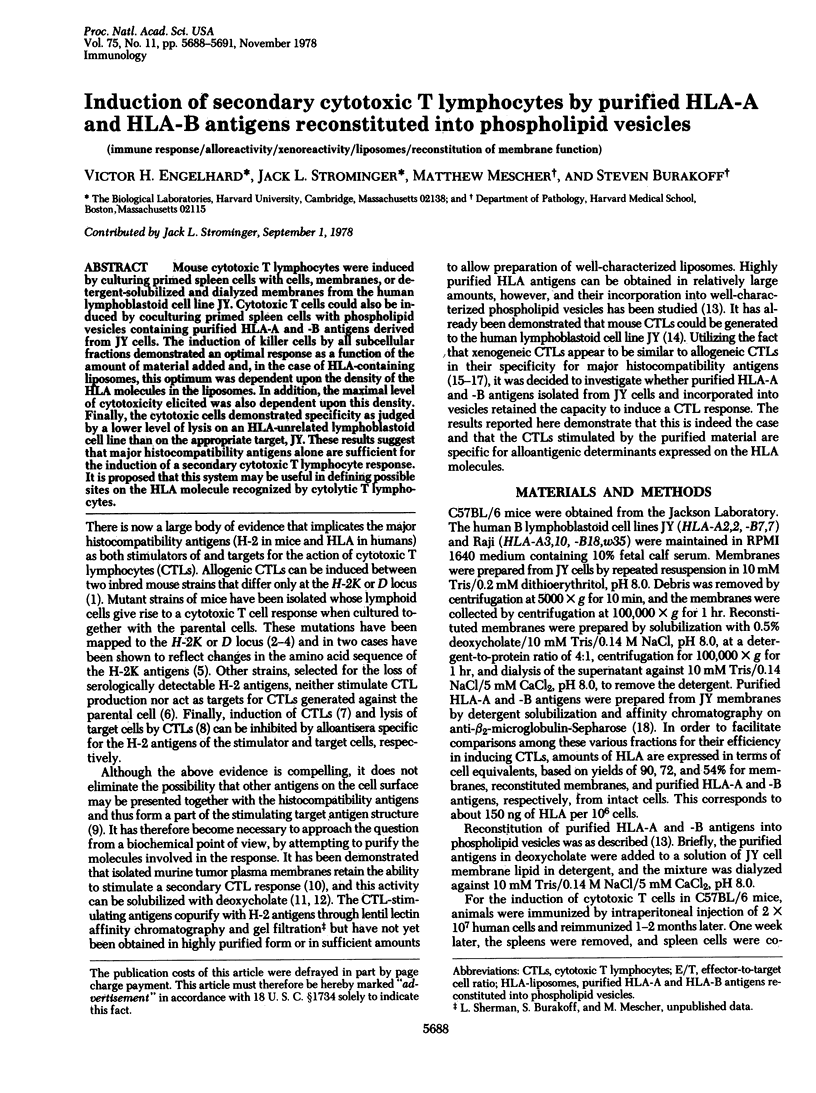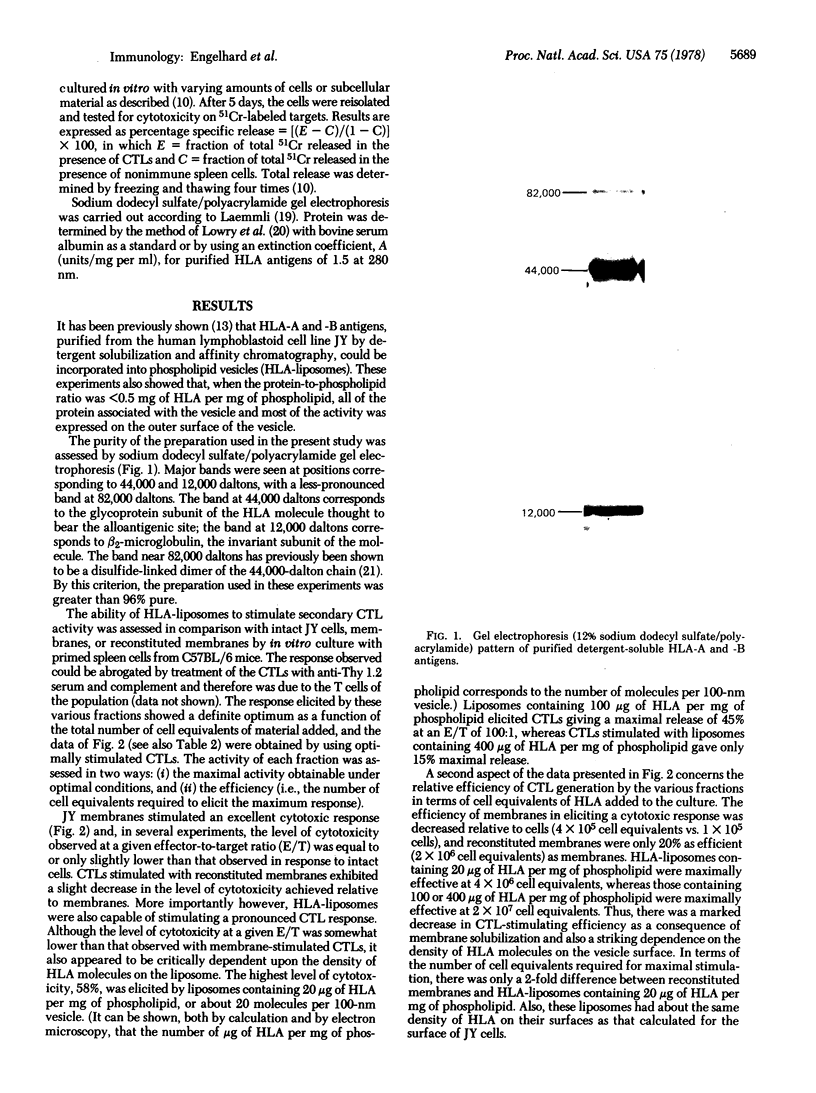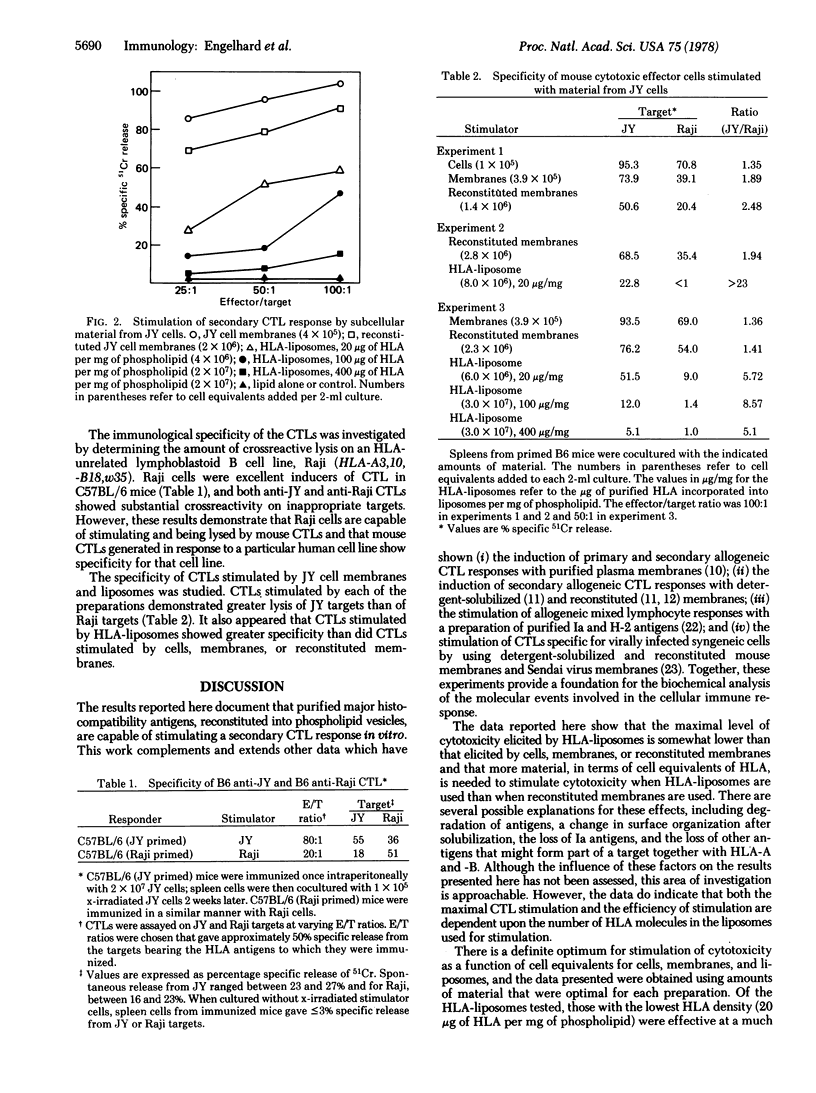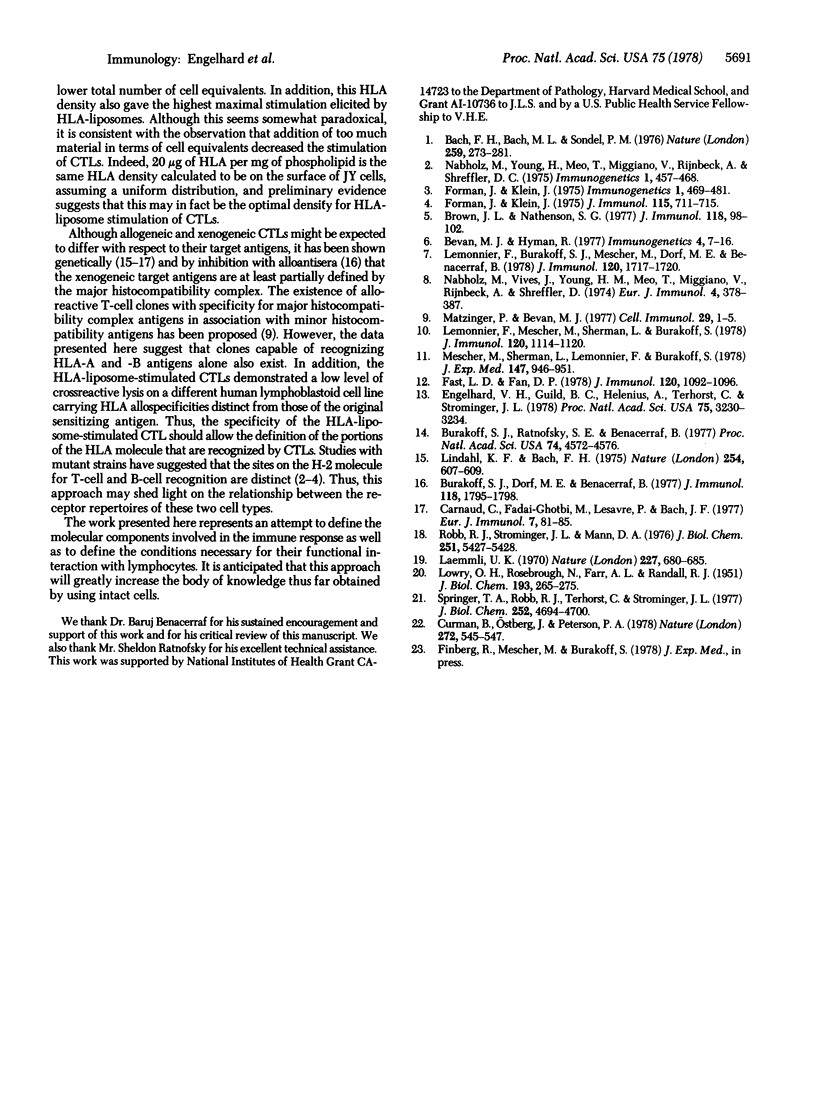Abstract
Mouse cytotoxic T lymphocytes were induced by culturing primed spleen cells with cells, membranes, or detergent-solubilized and dialyzed membranes from the human lymphoblastoid cell line JY. Cytotoxic T cells could also be induced by coculturing primed spleen cells with phospholipid vesicles containing purified HLA-A and -B antigens derived from JY cells. The induction of killer cells by all subcellular fractions demonstrated an optimal response as a function of the amount of material added and, in the case of HLA-containing liposomes, this optimum was dependent upon the density of the HLA molecules in the liposomes. In addition, the maximal level of cytotoxicity elicited was also dependent upon this density. Finally, the cytotoxic cells demonstrated specificity as judged by a lower level of lysis on an HLA-unrelated lymphoblastoid cell line than on the appropriate target, JY. These results suggest that major histocompatibility antigens alone are sufficient for the induction of a secondary cytotoxic T lymphocyte response. It is proposed that this system may be useful in defining possible sites on the HLA molecule recognized by cytolytic T lymphocytes.
Full text
PDF



Images in this article
Selected References
These references are in PubMed. This may not be the complete list of references from this article.
- Bach F. H., Bach M. L., Sondel P. M. Differential function of major histocompatibility complex antigens in T-lymphocyte activation. Nature. 1976 Jan 29;259(5541):273–281. doi: 10.1038/259273a0. [DOI] [PubMed] [Google Scholar]
- Brown J. L., Nathenson S. G. Structural differences between parent and mutant H-2K glycoproteins from two H-2K gene mutants: b6.c-h-2ba (Hzl) and B6-H-2bd (M505). J Immunol. 1977 Jan;118(1):98–102. [PubMed] [Google Scholar]
- Burakoff S. J., Dorf M. E., Benacerraf B. Specificity of rat xenogeneic cell-mediated cytolysis for the products of the K and D loci of the mouse H-2 complex. J Immunol. 1977 May;118(5):1795–1798. [PubMed] [Google Scholar]
- Burakoff S. J., Ratnofsky S. E., Benacerraf B. Mouse cytolytic T lymphocytes induced by xenogeneic rat stimulator cells exhibit specificity for H-2 complex alloantigens. Proc Natl Acad Sci U S A. 1977 Oct;74(10):4572–4576. doi: 10.1073/pnas.74.10.4572. [DOI] [PMC free article] [PubMed] [Google Scholar]
- Carnaud C., Fadaï-Ghotbi M., Lesavre P., Bach J. F. Education of human lymphocytes against mouse cells: specific recognition of H-2 antigens. Eur J Immunol. 1977 Feb;7(2):81–85. doi: 10.1002/eji.1830070206. [DOI] [PubMed] [Google Scholar]
- Curman B., Ostberg L., Peterson P. A. Incorporation of murine MHC antigens into liposomes and their effect in the secondary mixed lymphocyte reaction. Nature. 1978 Apr 6;272(5653):545–547. doi: 10.1038/272545a0. [DOI] [PubMed] [Google Scholar]
- Engelhard V. H., Guild B. C., Helenius A., Terhorst C., Strominger J. L. Reconstitution of purified detergent-soluble HLA-A and HLA-B antigens into phospholipid vesicles. Proc Natl Acad Sci U S A. 1978 Jul;75(7):3230–3234. doi: 10.1073/pnas.75.7.3230. [DOI] [PMC free article] [PubMed] [Google Scholar]
- Fast L. D., Fan D. P. Dissociated and reconstituted subcellular alloantigen capable of stimulating mouse cytotoxic T lymphocytes in vitro. J Immunol. 1978 Apr;120(4):1092–1096. [PubMed] [Google Scholar]
- Forman J., Klein J. Immunogeneic analysis of H-2 mutations. II. Cellular immunity to the H-2DA mutation. J Immunol. 1975 Sep;115(3):711–715. [PubMed] [Google Scholar]
- LOWRY O. H., ROSEBROUGH N. J., FARR A. L., RANDALL R. J. Protein measurement with the Folin phenol reagent. J Biol Chem. 1951 Nov;193(1):265–275. [PubMed] [Google Scholar]
- Laemmli U. K. Cleavage of structural proteins during the assembly of the head of bacteriophage T4. Nature. 1970 Aug 15;227(5259):680–685. doi: 10.1038/227680a0. [DOI] [PubMed] [Google Scholar]
- Lemonnier F., Burakoff S. J., Mescher M., Dorf M. E., Benacerraf B. Inhibition of the induction of cytolytic T lymphocytes with alloantisera directed against H-2K and H-2D gene products. J Immunol. 1978 May;120(5):1717–1720. [PubMed] [Google Scholar]
- Lemonnier F., Mescher T. M., sherman L., Burakoff S. The induction of cytolytic T lymphocytes with purified plasma membranes. J Immunol. 1978 Apr;120(4):1114–1120. [PubMed] [Google Scholar]
- Lindahl K. F., Bach F. H. Human lymphocytes recognise mouse alloantigens. Nature. 1975 Apr 17;254(5501):607–609. doi: 10.1038/254607a0. [DOI] [PubMed] [Google Scholar]
- Matzinger P., Bevan M. J. Hypothesis: why do so many lymphocytes respond to major histocompatibility antigens? Cell Immunol. 1977 Mar 1;29(1):1–5. doi: 10.1016/0008-8749(77)90269-6. [DOI] [PubMed] [Google Scholar]
- Mescher M., Sherman L., Lemonnier F., Burakoff S. The induction of secondary cytolytic T lymphocytes by solubilized membrane proteins. J Exp Med. 1978 Mar 1;147(3):946–951. doi: 10.1084/jem.147.3.946. [DOI] [PMC free article] [PubMed] [Google Scholar]
- Nabholz M., Vives J., Young H. M., Meo T., Miggiano V., Rijnbeek A., Shreffler D. C. Cell-mediated cell lysis in vitro: genetic control of killer cell production and target specificities in the mouse. Eur J Immunol. 1974 May;4(5):378–387. doi: 10.1002/eji.1830040514. [DOI] [PubMed] [Google Scholar]
- Robb R. J., Strominger J. L. Rapid purification of detergent-solubilized HLA antigen by affinity chromatography employing anti-beta2-microglobulin serum. J Biol Chem. 1976 Sep 10;251(17):5427–5428. [PubMed] [Google Scholar]
- Springer T. A., Robb R. J., Terhorst C., Strominger J. L. Submit and disulfide structure of monomeric and dimeric forms of detergent-soluble HLA antigens. J Biol Chem. 1977 Jul 10;252(13):4694–4700. [PubMed] [Google Scholar]



